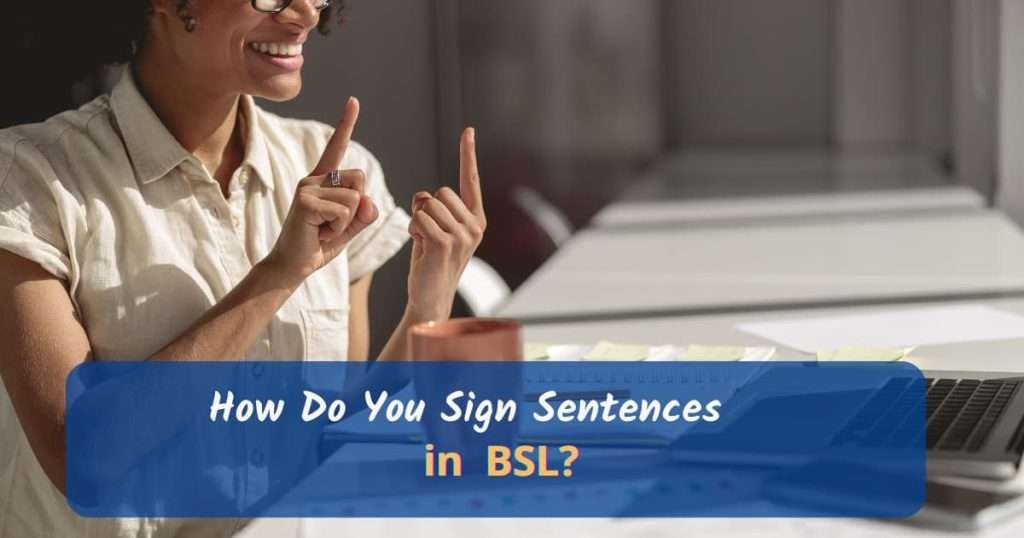How do you sign sentences in BSL? Sign sentences in BSL can be one of the easiest things to master. All languages have a subject, a verb and object. However the order changes from language to language. If you understand the basic rules of sentence structure then you will find creating sentences in BSL, super easy.
Many learners get confused about BSL sign order for a number of reasons. Perhaps the most obvious issue is that many learners think BSL follows English. Unfortunately, many videos online reinforce this. Video creators talk and use signs at the same time so signs follow what they are saying. Only fluent BSL users know that many of the videos on YouTube that teach sign language use sign supported English (SSE) not BSL.
This video is taken from a BBC series that was created by Dot Miles. The series was aimed at anyone interested in learning BSL. The video makes a number of important points including:
1. BSL is not SSE
Most learners who have English as their first language, think in English and use this to translate into BSL when they are signing. English is ‘linear’ in that one word must follow another. BSL, is different. You can create several signs at the same time.
Sign Order is important as it relates to meaning. If signs are not combined following the correct language (syntax) rules, the meaning is lost or becomes unclear. Visually, you have to know what is being discussed.
2. Sign order includes:
- Body language: e.g. is the body tilted forward or backwards to indicate when an action happened/will happen
- Lip patterns: some English words are mouthed (not spoken) when signing to indicate which sign is being used e.g. please and thank you
- Lip patterns: some facial expressions act like adverbs e.g. puffing cheeks when signing can show an object getting bigger
- Facial expressions: parallel mouth signs (also multi-channel signs) are signs that would be translated into more than one word
- Placement: where a sign is placed in the space at the front of the body can indicate when something happened
3. BSL has a Topic-Comment structure
BSL has what’s known as a ‘topic-comment’ structure. Interestingly, some east Asian languages have the same structure. A simple example of a topic-comment structure is:
English: There is a red car
BSL: Car – red – there (the sign for ‘there’ is what is known as a multi-channel sign).
Imagine a big house in front of you. In English you would say ‘that’s a big house’. In BSL, we see the house first then the size and any other description. So, in BSL you would sign ‘house – big – there (point)’
4. Time in BSL works differently
BSL structure is usually ‘Time – topic- comment. You have to put when something has happened or will happen at the beginning of the sentence. For example:
English: I’m on holiday next week
BSL: Next week-holiday-me
Context in BSL is important
Many learners believe that BSL equates to ‘one word = one sign’. It is important to understand that BSL signs change according to context. Context in BSL is important for understanding what is happening. FDA Deaf Studies has a YouTube clip that gives several examples of how BSL changes depending on the context. One example of changing contexts is the word ‘back’
- My back is aching
- My client is back again
- The back of a book
- Go back the way you came
- I’ve decided to back this business
- Reverse your car back
In English, ‘back’ is only one word but in BSL each sign for ‘back’ would be different because the context is different in each sentence.
Questions in BSL are at the end of a sentence
In English we tend to start the sentence with a question but in BSL the questions are at the end. For a more detailed explanation on questions in BSL, you can look at our post how to sign questions in BSL. We’ve outlined a few examples below:
- English: where is the car? = BSL: car where?
- English: I was born in London = BSL: me born where? London
- English: what is your name? = BSL: name what?
- English: where do you live? = BSL: live where?
Other BSL resources
Minna from SignHow YouTube. Minna’s videos do not have any subtitles so are suited to students on a BSL Level 2 or Level 3 course.

